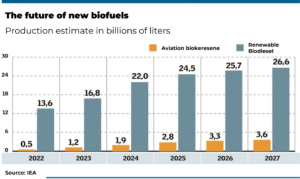International Biodiesel Day: What is it and how did it originate?
We explain what biodiesel is, how it originated, how it is produced, and the main benefits of this renewable energy commodity.
On August 10th, we celebrate International Biodiesel Day, a tribute to this renewable energy source that raises awareness about the importance of non-fossil fuels.
Growing concerns about social, economic, and environmental issues have led to a trend in the commodities market, making biodiesel an alternative to diversify the energy market. In countries like the United States and Brazil, its production gains strength each year, increasing the share of this commodity that complements the energy matrix.
In this text, we explain everything you need to know about biodiesel!
What is biodiesel and how is it produced?
Biodiesel is a fuel made from vegetable oil or animal fat, making it biodegradable and renewable. As a result, it is considered a clean and organic energy commodity.
Its production can be carried out with methanol (usually synthesized from wood biomass), resulting in methyl ester, or with ethanol, in the form of ethyl ester (from sugarcane). In both processes, glycerin is produced as a byproduct, which can enhance the competitiveness of biodiesel, as this substance is a raw material in the production of paints, adhesives, pharmaceuticals, etc.
The raw materials for vegetable oil production (used in biodiesel) are varied. Among them, we can highlight sunflower oil, soybean oil, palm oil, cotton, corn, and other crops that vary according to agricultural aptitude and the specific climate of each region. In the case of animal fat, it can come from bovine, swine, and poultry tallow.

Austin Hagerty, Head of Desk Sales – Energy US/LATAM
“The biodiesel industry is exposed to price volatility across several commodity markets given its inherent exposure to both Energy and Agricultural markets. Given the ever-changing landscape of this market, finding a risk manager who understands the fundamentals affecting the grains, oilseeds, and energy markets is crucial to formulating a proper comprehensive risk management strategy,” Austin Hagerty, Head of Desk Sales – Energy US/LATAM
How did biodiesel originate?
The history of biodiesel began in 1895 when Rudolf Diesel and Henry Ford discovered vegetable oils as a fuel to drive industrial development. They researched various fuels that could be used in engines, such as alcohol produced from biomass.
This initiative was the starting point for vegetable oil to be associated with alcohol. Thus, a chemical process called transesterification was originated, characterized by the separation of glycerin from vegetable oil. The result? The creation of a new renewable fuel, vegetable oil ester, known as biodiesel.
Biodiesel: diversifying the energy matrix
The use of biodiesel is an alternative to diversify a nation’s energy matrix. In this way, it reduces the exclusive dependence on petroleum as a fuel source.
Countries can, therefore, become less vulnerable to variations in oil prices and supply chain disruptions. Additionally, biodiesel production is linked to specific oilseed crops, such as soybeans or palm, significantly boosting this market.
Biodiesel can also be produced from animal fats and cooking oils used, reducing the amount of waste that would be improperly discarded. The development of biodiesel thus contributes to boosting agriculture and the economy, generating employment opportunities.
What are the main biodiesel-producing countries?
In 2022, the main biodiesel-producing countries, according to the International Renewable Energy Agency (IRENA), were:
- Brazil: 5.9 billion liters.
- United States: 4.8 billion liters.
- Indonesia: 3.3 billion liters.
- Germany: 1.4 billion liters.
- Argentina: 1.2 billion liters.
According to the International Energy Agency (IEA) report, Brazil, India, and Indonesia are expected to lead the world’s biofuel demand growth between 2023 and 2024. These nations have ample availability of raw materials to expand production and are investing in biodiesel development to offset part of petroleum derivative imports.
Renewable diesel: an ally in sustainable energy transition
Renewable diesel is often confused with biodiesel, as they are both clean fuels but with distinct chemical properties. Known as green diesel, it can be produced in different ways, such as:
- From the hydrotreatment of vegetable oils or animal fats.
- From the synthesis of synthesis gas molecules obtained by gasifying organic waste.
- By fermenting sugarcane.
Its composition is like petroleum-derived diesel. Therefore, it can be blended with mineral diesel in any proportion, even in full replacement. Hydrotreated Vegetable Oil (HVO) is one of the main types of renewable diesel.
It results from the hydrogenation of vegetable oils, animal fats, microorganisms, and waste, such as used cooking oil. HVO is the third most used biofuel in the world. Among its benefits, we can mention:
- Free of contaminants.
- Higher stability, ensuring fewer problems in storage and use in diesel engines.
- Reduced risks, such as clogging of filters, pumps, and injectors, increasing vehicle life.
- High cetane number, improving combustion quality in the engine.
In the chart, you can see the estimated production of renewable diesel.
Source: International Energy Agency
hEDGEpoint: why is risk management crucial in this market?
The biodiesel market is subject to various factors and can be highly volatile. One of its main fluctuations is in the prices of agricultural commodities, which directly affect biodiesel production costs and can be influenced by climate and local and global economies.
Additionally, demand can change due to new government policies, causing price fluctuations. In this scenario, risk management becomes crucial for your business.
hEDGEpoint has experts across the globe in agricultural and energy markets with an ever-changing focus on combining these skillsets and addressing the needs of customers with exposure to both sides of the biofuels markets.
We combine market intelligence with risk management tools, offering data and insights.
Contact a hEDGEpoint professional to learn more.







